|
Getting your Trinity Audio player ready...
|
OWN VOICE ~ InPerspective by Gregg Dieguez. The topic of Sweden has become another politically/ideologically polarizing one during the Pandemic. Some on the Left seem to hope that Sweden suffers catastrophic deaths to help justify the societal restrictions they favor here – to prioritize lives over finances. Some on the Right seem to hope Sweden succeeds in “staying open” with low or comparable deaths to justify their demands for “freedom” and an end to CV-19-driven restrictions which are damaging our economy. Time will tell, but it is possible that NEITHER side will get the proof that they want, and that the REAL lesson from Sweden is: C) None of the Above.
You may have heard that Sweden:
A) decided to keep society open and let the COVID-19 virus run its course, deaths or no deaths, and
B) had deaths 3 and 6 times as high as neighboring Scandanavian countries.
You’d be half right. Deaths per million in Sweden rank it 7th-worst in the world, two spots ahead of the U.S., which is 9th worst. Sweden is thus 7.5 times worse than Denmark and 3.4 times worse than Norway.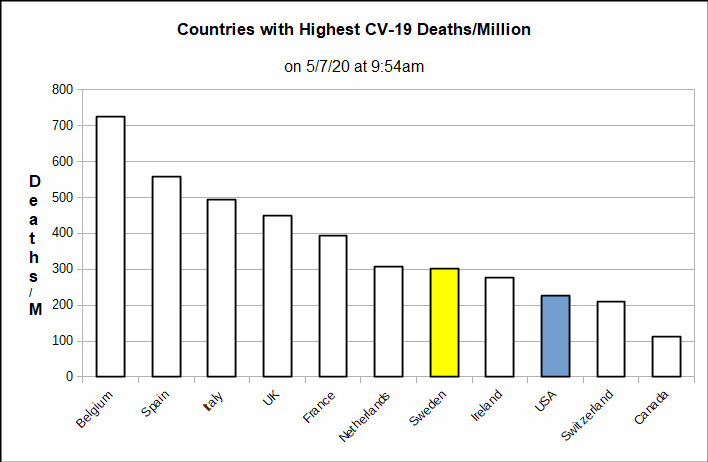 [1]
[1]
Sweden did not take CV-19 lightly, and they are not fully open. There are restrictions on:
- gatherings of over 50 people
- air travel
- immigration
- safety protocols (wash hands, social distance, work at home where possible and avoid travel over holidays, stay home if sick)
- Anyone aged 70 or older has been told to stay at home
What they are NOT doing is:
-
-
- closing schools for young kids (older students do study at home): Principal Lisa Norming said it was vital for her students’ health to be able to come to school. “It means a huge deal,” she said. “It’s about structure and daily routines they need to feel well.” “We know that closing down schools has a lot of effects on health care because a lot of people can’t go to their work anymore. A lot of children are suffering when they can’t go to school.”
- closing restaurants
- closing ski slopes
- telling people to stay indoors: “People should go out, exercise, get fresh air. It’s good for their physical and mental health.”
- following the “herd immunity” theory[2] “Sweden’s strategy, she said, was: “No lockdown and we rely very much on people taking responsibility themselves.”
- overloading their health care system
- shutting down mass transit: “The subway went from being completely packed to having only a few passengers per car. I get the sense that a vast majority are taking the recommendations of social distancing seriously.”
As a Swedish resident pointed out, “there is also a homogeneity of culture that contributes to successfully executing broad programs which would never happen in the U.S..”
Despite avoiding a full Lockdown, Sweden’s export-dependent economy has been hit hard and unemployment is seen rising. The government has launched relief measures worth about 100 billion Swedish kronor ($9.9bn) but still expects the economy to contract four percent this entire year. Note that the U.S. economy contracted 4.8% in the first quarter, and is expected to contract 30-40% in the 2nd quarter. Sweden’s performance would be slightly better than projected for the U.S. – depending hugely upon whether the U.S.’s Third Quarter is a return to normalcy, or not. [3]
So how will this work out?
Sweden is better prepared to weather the CV-19 storm than some other countries. Some 40% of the country’s workforce worked from home regularly, even before the virus struck, and Sweden has a high ratio of people living on their own, whereas in southern Europe it’s not uncommon to have three generations under one roof. Of course, Sweden is prepared for this lifestyle because it has the second fastest average internet connection speed in the world (2018) (The U.S. ranked 15th.)
There’s another clue in that list above – their health care system is not overloaded. Why not? We’ve been told to flatten the curve; we’d destroy our health care system and kill a million or more extra people if we didn’t. And that was probably a valid observation, here in the U.S.
Sweden, however, has had national health care for decades. People are routinely treated with health maintenance regimens, as you would here – were you enrolled in
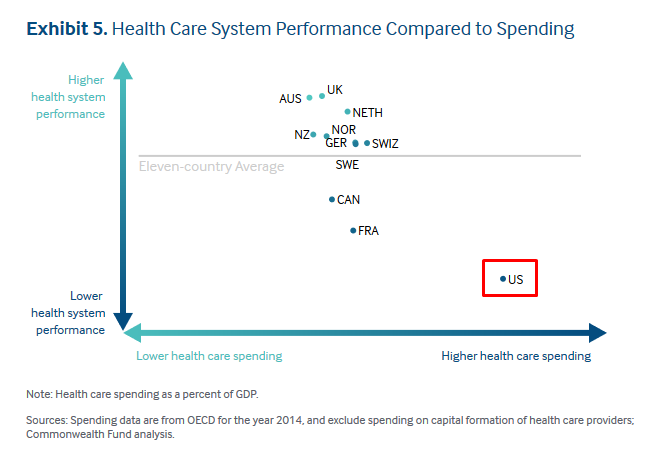 an HMO. Sweden doesn’t have more hospital beds or ICU units than the U.S. They have a larger homeless rate than the U.S. (at least compared to what we admit). They are even older: their average age is 41 years, compared to the U.S. 38. What they have is a healthier population.
an HMO. Sweden doesn’t have more hospital beds or ICU units than the U.S. They have a larger homeless rate than the U.S. (at least compared to what we admit). They are even older: their average age is 41 years, compared to the U.S. 38. What they have is a healthier population.Another factor in Sweden’s favor is a generous social welfare safety net that means, for example, people don’t feel obligated to turn up for work if their young child is sick. State support kicks in on day one of absence from work due to a child being sick. “The system here was already well set up to help people to make smarter choices which ultimately benefit the wider population.”
And it’s not just because of the healthcare system. Sweden has a poverty rate half of the U.S. rate (1% under $5.50/day, 2% U.S.). Inequality in Sweden is 28% lower than in the U.S. And those metrics don’t fully capture the difference in quality of life for the working class. In the U.S. if you have a low-paying job with a jerk for a boss, you likely have to stick with it because your family needs the money and the health insurance. In Sweden, you can change jobs without losing health insurance. In the U.S. companies try to AVOID having employees, using contractors and the gig economy to avoid providing health care and vacation benefits. In Sweden, you get 25 paid vacation days and 16 paid holidays, plus you get 80% of pay can stay at home from work for up to 14 days before requiring a doctor’s note.
Capitalists in the U.S. criticize Sweden as a socialist welfare state. Capitalists want to make money and tend to care less about worker welfare in the long run. Note that in the U.S. 30% of the population is below 200% of the poverty line, which was annual earnings of $25,750 for a family of four in 2019 – thus less than $52,000. 63% of Americans don’t have enough savings to cover a $500 emergency.
Note also that the distribution of CV-19 deaths in the U.S. is much higher for people of color. The latest available COVID-19 mortality rate for Black Americans is
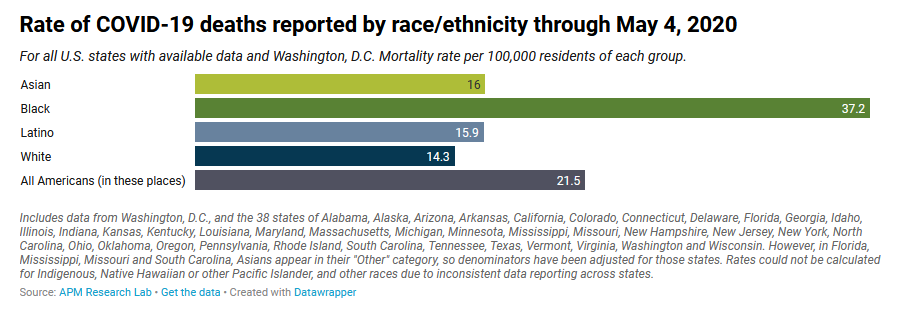 approaching triple the rate for Whites. Some of this is because they cannot work from home as much due to lower skilled jobs, and/or because they have worse nutrition and more obesity and diabetes.
approaching triple the rate for Whites. Some of this is because they cannot work from home as much due to lower skilled jobs, and/or because they have worse nutrition and more obesity and diabetes.Did you notice the official warnings from Scandinavian countries to their citizens when the CV-19 outbreak started? They told citizens to return home if they were in a foreign country with bad healthcare – like the United States. And our healthcare system is the worst among comparably advanced OECD countries.
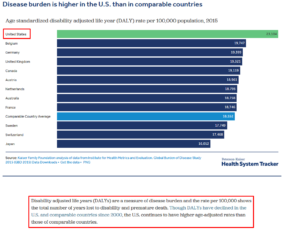
Click to Enlarge. Data is before Opioid and CV-19 deaths made things worse in U.S. So, a lower proportion of Americans have health insurance; we have less of a safety net to fall back on than in Sweden; and more of us are in worse physical and financial health. Even with the lockdown in the U.S., we’re not that far behind Sweden in CV-19 cases or deaths. Were the U.S. to have tried Swedish policies, we almost certainly would have triggered even more massive deaths among our larger vulnerable populations.
The Pandemic is a test. It’s a test of countries’ governments and of their entire society. During the Spanish Flu, there were 3 waves of infection over 2 years, before it died out. It could take two more years to determine which countries followed the most effective policies for both public and economic health. Today, Sweden is losing to the U.S. on CV-19 death rate, but winning on economic health. However, both measures bear watching over the next 2 years, as U.S. deaths continue to accelerate. The U.S. could end up with the worst of both worlds, both more economic damage and more CV-19 deaths. And if we perform worse than Sweden in this test, the lesson won’t just be about public health policies, it will be about the entire structure of our society.
-
COVID Update May 6: Like many countries we picked a strategy to beat COVID-19. We just decided not to stick to it. 1/
— Andy Slavitt 🇺🇦 (@ASlavitt) May 6, 2020
^ That thread is worth reading (under 5 mins).
Humorous Postscript: So Sweden is incorporating a discipline of personal responsibility in its strategy – partly because their democratic society resists strict enforcement of lockdowns, as do we. With a more homogeneous society which has greater respect for the experts in its government, personal responsibility might work. However, they’re realistic. So, when the annual bacchanalia called Walpurgis Night – which involves gathering in parks and drinking tons of booze – arrived, the university town of Lund filled the party park with smelly chicken manure to keep the students away. “This is a park where usually 30,000 people gather, but with COVID-19 this is now unthinkable,” Philip Sandberg, the town’s mayor, told Reuters. “We don’t want Lund to become an epicentre for the spread of the disease.”
__________________________________
Footnotes:
[1]
Early CV-19 Exposure
Newly discovered cases of CV-19 in Dec. in France argue that Europe was exposed early, as were the U.S. East and West Coasts, so Sweden’s high death rate could partly be because they started earlier, while our Mid-western spread is just taking off.
[2]
Limitations of Herd Immunity
Perhaps most important to understand, the virus doesn’t magically disappear when the herd immunity threshold is reached. That’s not when things stop — it’s only when they start to slow down. Full discussion here.
[3]
2020 Economic Forecasts
US CBO 2020 projections: https://www.cbo.gov/publication/56335 – most expect 3Q return to normalcy – which is optimistic. https://www.kiplinger.com/article/business/T019-C000-S010-gdp-growth-rate-and-forecast.html Only 5% decline for 2020: https://www.reuters.com/article/us-usa-gdp-pimco/us-gdp-will-contract-30-in-second-quarter-5-in-2020-pimco-idUSKCN21Q2VL





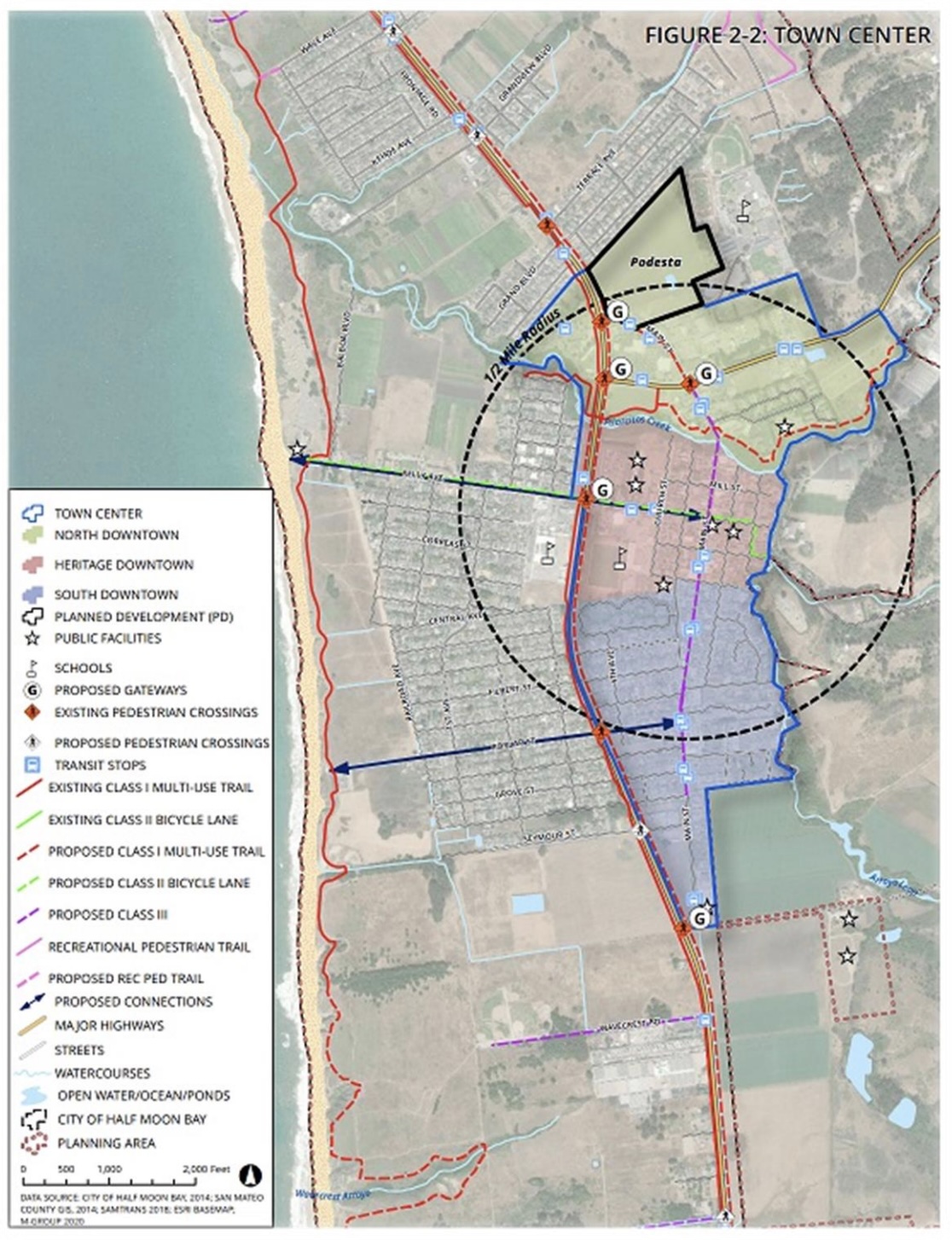

very informative. solid research and great presentation. thank you.